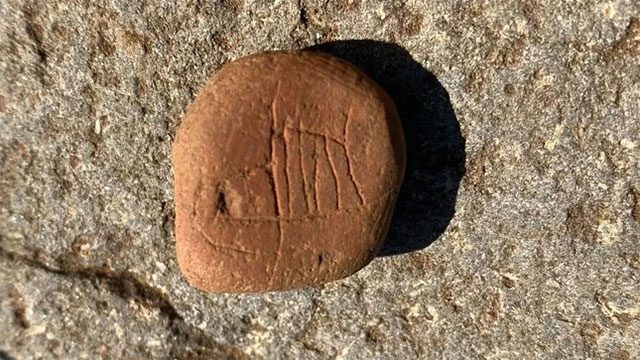Icelandic archaeologists have unearthed the oldest known graffiti drawing in the country—a scratched depiction of a Viking ship.
Bjarni F. Einarsson, an archaeologist and manager at the private firm Fornleifafræðistofan (Archaeological Office), and the excavation team leader for the project, stated that researchers found the graffiti in the remains of a longhouse. The scrawl was carved on a piece of red clay measuring 2.5 cm wide, dating back to shortly after 800 AD.

The oldest known graffiti drawing in Iceland depicts a Viking ship, including a sail, a rope connecting the sail to the front of the vessel, and an incomplete hull. (Photo: Bjarni F. Einarsson).
Einarsson mentioned that the ship is incomplete, which is typical of graffiti depicting Viking ships. However, the carving shows a sail with vertical lines, a rope from the sail to the front of the ship, and a portion of the hull drawn. Einarsson said, “It is very common for ships not to be fully depicted.”
He noted that images of ships from the Viking Age are common in Scandinavia and are often found on pieces of bone, stone, and wood.
The Vikings carved various images wherever they went
Einarsson stated, “We do not know why people carved these ships on all types of materials. But they were made very simply. They are not masterpieces.”
The clay stone is just one of many artifacts discovered in the longhouse that Einarsson uncovered at Stöð, eastern Iceland, in 2007 while conducting an archaeological survey for a company intending to lay fiber optic cables in the area.
Radiocarbon dating and tephra (volcanic ash) analysis indicate that the Vikings lived and built here over three phases: before 800 AD, shortly after 800, and finally in the latter half of the 800s. These dates align with the known arrival of the Vikings in Iceland; the 12th-century “Book of Settlements”, which describes the initial settlement days in Iceland, states that the Viking explorers arrived in the 870s.
Einarsson noted that archaeological evidence suggests humans arrived before that time, but the exact dates of the first arrivals remain unknown.
Artifacts unearthed from the late 9th century include lead weights, silver hacks (a form of currency), and traces of gold, indicating that the Vikings who lived there were traders.
Einarsson discovered the graffiti drawing of the ship while excavating a wall approximately 43 meters long. In other words, the Vikings carved various images wherever they went. Einarsson mentioned that other Viking Age graffiti includes geometric patterns, runic inscriptions with ambiguous text, and even some explicit content.


















































